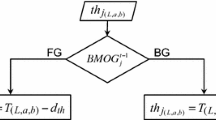Abstract
Background subtraction being one of the most crucial steps in numerous real-world video-based applications has been studied extensively to date. Several researchers have provided solutions to this problem by exploiting the patterns and information hidden in a set of initial raw videoframes with the help of sophisticated machine learning techniques. While others have proposed to uncover the hidden patterns in raw data by employing a variety of texture patterns, which now have become an inseparable part of the background subtraction problem. Hence, the paper proposes to employ a novel feature combination of Attractive–repulsive local binary gradient contours with RGB channels and luminance information into a consensus-based modeling technique. The results obtained on sample videos from the standard Change Detection dataset [1] support for the superiority of the proposed methodology.
Access this chapter
Tax calculation will be finalised at checkout
Purchases are for personal use only
Similar content being viewed by others
References
Goyette N, Jodoin P-M, Porikli F, Konrad J, Ishwar P (2012) Changedetection.net: a new change detection benchmark dataset. In: 2012 IEEE computer society conference on computer vision and pattern recognition workshops, IEEE, pp 1–8
Baskar A, Kumar TG (2018) Facial expression classification using machine learning approach: a review. In: Data engineering and intelligent computing, Springer, pp 337–345
Paresh PA, Parameswaran L (2018) Vision-based algorithm for fire detection in smart buildings. In: International conference on ISMAC in computational vision and bio-engineering, Springer, pp 1029–1038
Srenithi M, Kumar P (2018) Motion detection algorithm for surveillance videos. In: International conference on ISMAC in computational vision and bio-engineering, , Springer, pp 955–964
Muthugnanambika M, Bagyammal T, Parameswaran L, Vaiapury K (2018) An automated vision based change detection method for planogram compliance in retail stores. In: Computational vision and bio inspired computing, Springer, pp 399–411
Zhan C, Duan X, Xu S, Song Z, Luo M (2007) An improved moving object detection algorithm based on frame difference and edge detection. In: Fourth international conference on image and graphics (ICIG 2007), IEEE, pp 519–523
Kilger M (1992) A shadow handler in a video-based real-time traffic monitoring system. In: Proceedings IEEE workshop on applications of computer vision, IEEE, pp 11–18
Stauffer C, Grimson WEL (1999) Adaptive background mixture models for real-time tracking. In: Proceedings. 1999 IEEE computer society conference on computer vision and pattern recognition (Cat No PR00149), vol 2, IEEE, pp 246–252
Zivkovic Z (2004) Improved adaptive Gaussian mixture model for background subtraction. In: Proceedings of the 17th international conference on pattern recognition. ICPR 2004., vol 2, IEEE, pp 28–31
Xiuman D, Guoxia S, Tao Y (2011) Moving target detection based on genetic k-means algorithm. In: 2011 IEEE 13th international conference on communication technology, IEEE, pp 819–822
Lin H-H, Liu T-L, Chuang J-H (2002) A probabilistic svm approach for background scene initialization. In: Proceedings. International conference on image processing, vol 3, IEEE, pp 893–896
Tavakkoli A, Nicolescu M, Bebis G, Nicolescu M (2008) Efficient background modeling through incremental support vector data description. In: 2008 19th international conference on pattern recognition, IEEE, pp 1–4
Zhou X, Yang C, Yu W (2012) Moving object detection by detecting contiguous outliers in the low-rank representation. IEEE Trans Pattern Anal Mach Intell 35(3):597–610
Xu Z, Gu IY-H, Shi P (2008) Recursive error-compensated dynamic eigenbackground learning and adaptive background subtraction in video. Opt Eng 47(5):057001
Zivkovic Z, Van Der Heijden F (2006) Efficient adaptive density estimation per image pixel for the task of background subtraction. Pattern Recognit Lett 27(7):773–780
Barnich O, Van Droogenbroeck M (2011) ViBe: a universal background subtraction algorithm for video sequences. IEEE Trans Imag Process 20(6):1709–1724
Shah M, Deng JD, Woodford BJ (2015) A self-adaptive codebook (sacb) model for real-time background subtraction. Imag Vis Comput 38:52–64
Wang H, Suter D (2006) Background subtraction based on a robust consensus method. In: 18th international conference on pattern recognition (ICPR’06), vol 1, IEEE, pp 223–226
Heikkilä M, Pietikäinen M, Schmid C (2009) Description of interest regions with local binary patterns. Pattern Recognit 42(3):425–436
Silva C, Bouwmans T, Frélicot C (2015) An extended center-symmetric local binary pattern for background modeling and subtraction in videos. In: International joint conference on computer vision, imaging and computer graphics theory and applications, VISAPP 2015
El Khadiri I, Kas M, El Merabet Y, Ruichek Y, Touahni R (2018) Repulsive-and-attractive local binary gradient contours: new and efficient feature descriptors for texture classification. Inform Sci 467:634–653
Bilodeau G-A, Jodoin J-P, Saunier N (2013) Change detection in feature space using local binary similarity patterns. In: International conference on computer and robot vision, CRV 2013, IEEE, pp 106–112
St-Charles P-L, Bilodeau G-A, Bergevin R (2016) Universal background subtraction using word consensus models. IEEE Trans Imag Process 25(10):4768–4781
Singh RP, Sharma P (2020) Instance-vote-based motion detection using spatially extended hybrid feature space. Vis Comput, 1–17
Singh RP, Sharma P (2020) A light-weight change detection method using ycbcr-based texture consensus model. Int J Pattern Recognit Artif Intell 34(09):2050023
Singh RP, Sharma P, Madarkar J (2019) Compute-extensive background subtraction for efficient ghost suppression. IEEE Access 7:130180–130196
Sajid H, Cheung S-CS (2017) Universal multimode background subtraction. IEEE Trans Imag Process 26(7):3249–3260
Heikkila M, Pietikainen M (2006) A texture-based method for modeling the background and detecting moving objects. IEEE Trans Pattern Anal Mach Intell 28(4):657–662
Author information
Authors and Affiliations
Corresponding author
Editor information
Editors and Affiliations
Rights and permissions
Copyright information
© 2021 The Author(s), under exclusive license to Springer Nature Singapore Pte Ltd.
About this paper
Cite this paper
Singh, R.P., Sharma, P. (2021). Using Attractive–Repulsive Binary Local Gradient Contours for Sample-Consensus Background Modeling. In: Tiwari, A., Ahuja, K., Yadav, A., Bansal, J.C., Deep, K., Nagar, A.K. (eds) Soft Computing for Problem Solving. Advances in Intelligent Systems and Computing, vol 1393. Springer, Singapore. https://doi.org/10.1007/978-981-16-2712-5_54
Download citation
DOI: https://doi.org/10.1007/978-981-16-2712-5_54
Published:
Publisher Name: Springer, Singapore
Print ISBN: 978-981-16-2711-8
Online ISBN: 978-981-16-2712-5
eBook Packages: Intelligent Technologies and RoboticsIntelligent Technologies and Robotics (R0)




